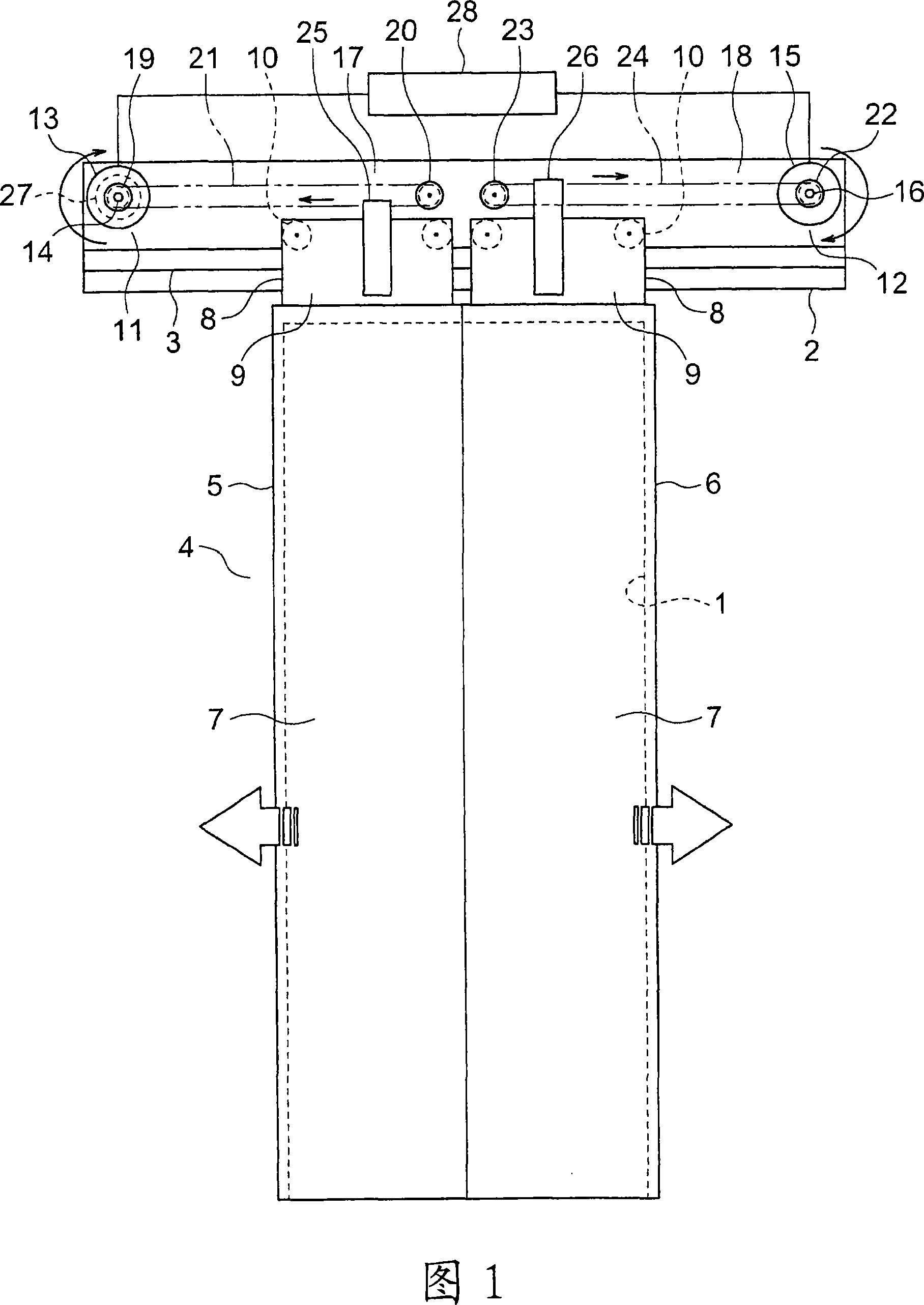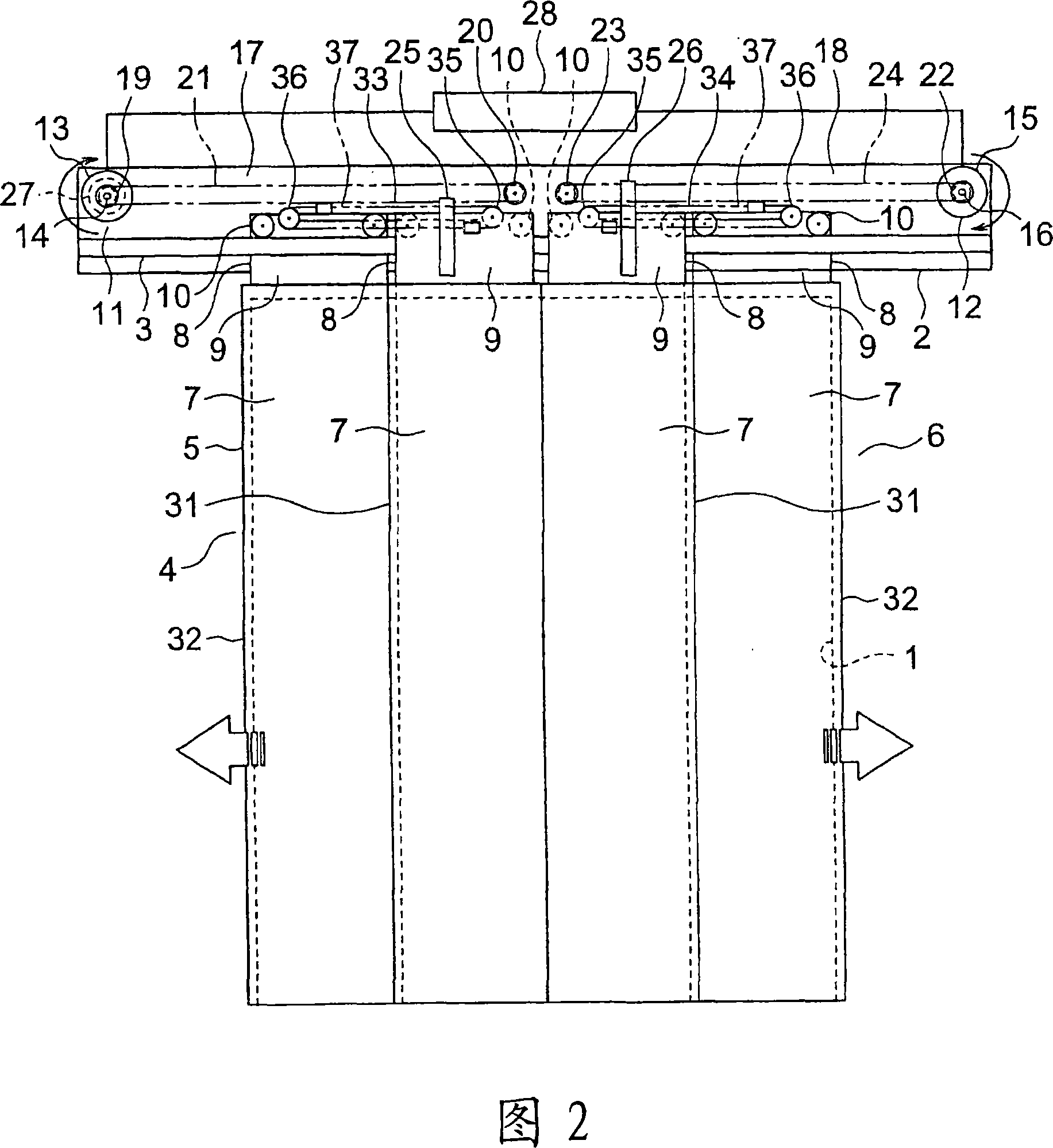Elevator door apparatus
A technology for elevator doors and elevators, which is used in elevators, transportation and packaging, elevators and other directions in buildings, and can solve the problems that the miniaturization of the motor cannot be realized, the life of the belt cannot be prolonged, and the burden becomes larger.
- Summary
- Abstract
- Description
- Claims
- Application Information
AI Technical Summary
Problems solved by technology
Method used
Image
Examples
Embodiment approach 1
[0017] Fig. 1 is a front view showing an elevator door apparatus according to Embodiment 1 of the present invention. In FIG. 1 , a car doorway (elevator doorway) 1 is provided on a car (not shown). In addition, a hanger case 2 provided on the upper part of the car entrance 1 is fixed to the car.
[0018] A hanging door rail (support rail) 3 extending in the width direction of the car doorway 1 is fixed to the hanging door box 2 . An elevator door 4 for opening and closing the car doorway 1 is suspended on the hanging door rail 3 .
[0019] The elevator door 4 has a first door 5 and a second door 6 movable in the width direction of the car doorway 1 . The first door 5 and the second door 6 are arranged side by side with each other in the width direction of the car doorway 1 . The car doorway 1 is closed when the first door 5 and the second door 6 contact each other, and is opened when the first door 5 and the second door 6 are separated.
[0020] The first door 5 can be pos...
Embodiment approach 2
[0049] Fig. 3 is a front view showing an elevator door device according to Embodiment 2 of the present invention. In addition, FIG. 4 is a plan view showing a part of the elevator door apparatus of FIG. 3 . In the drawing, an interlocking mechanism 41 for synchronizing the moving speed of the first door 5 and the moving speed of the second door 6 is provided between the first power transmission mechanism 17 and the second power transmission mechanism 18 .
[0050] The interlocking mechanism 41 has: a first interlocking pulley 42 that rotates integrally with the first driven pulley 20; a second interlocking pulley 43 that rotates integrally with the second driven pulley 23; The ring-shaped interlocking bar body 44 between the movable pulleys 43.
[0051] The first interlocking pulley 42 is provided coaxially with the first driven pulley 20 , and the second interlocking pulley 43 is provided coaxially with the second driven pulley 23 . The bar body 44 for interlocking moves ci...
Embodiment approach 3
[0055] Fig. 5 is a front view showing an elevator door device according to Embodiment 3 of the present invention. In the figure, the encoder 27 which generates the signal corresponding to the rotation of the 1st rotating shaft 14 is provided in the 1st door driver 11 as a 1st position detector. Moreover, the encoder 51 which generates the signal corresponding to the rotation of the 2nd rotation shaft 16 is provided in the 2nd door driver 12 as a 2nd position detector.
[0056] Information from the respective encoders 27 and 51 is input to the door control device 28 . The door control device 28 has: a first door control unit 52 that controls the first door driver 11 based on information from the encoder 27; and a second door control unit 53 that controls the second door driver 12 based on information from the encoder 51. . That is, the door control device 28 has the 1st door control part 52 and the 2nd door control part 53 which control the 1st door drive device 11 and the 2n...
PUM
 Login to View More
Login to View More Abstract
Description
Claims
Application Information
 Login to View More
Login to View More - R&D
- Intellectual Property
- Life Sciences
- Materials
- Tech Scout
- Unparalleled Data Quality
- Higher Quality Content
- 60% Fewer Hallucinations
Browse by: Latest US Patents, China's latest patents, Technical Efficacy Thesaurus, Application Domain, Technology Topic, Popular Technical Reports.
© 2025 PatSnap. All rights reserved.Legal|Privacy policy|Modern Slavery Act Transparency Statement|Sitemap|About US| Contact US: help@patsnap.com



